Monday, October 13th 2008

Core i7 940 Review Shows SMT and Tri-Channel Memory Let-down
As the computer enthusiast community gears up for Nehalem November, with reports suggesting a series of product launches for both Intel's Core i7 processors and compatible motherboards, Industry observer PC Online.cn have already published an in-depth review of the Core i7 940 2.93 GHz processor. The processor is based on the Bloomfield core, and essentially the Nehalem architecture that has been making news for over an year now. PC Online went right to the heart of the matter, evaluating the 192-bit wide (tri-channel) memory interface, and the advantage of HyperThreading on four physical cores. In the tests, the 2.93 GHz Bloomfield chip was pitted against a Core 2 Extreme QX9770 operating at both its reference speed of 3.20 GHz, and underclocked to 2.93 GHz, so a clock to clock comparison could be brought about.
The evaluation found that the performance increments tri-channel offers over dual-channel memory, in real world applications and games, are just about insignificant. Super Pi Mod 1.4 shows only a fractional lead for tri-channel over dual-channel, and the trend continued with Everest Memory Benchmark. On the brighter side, the integrated memory controller does offer improvements over the previous generation setup, with the northbridge handling memory. Even in games such as Call of Duty 4 and Crysis, tri-channel memory did not shine.As for the other architectural change, simultaneous multi-threading, that makes its comeback on the desktop scene with the Bloomfield processors offering as many as eight available logical processors for the operating system to talk to, it appears to be a mixed bag, in terms of performance. The architecture did provide massive boosts in WinRAR and Cinebench tests Across tests, enabling SMT brought in performance increments of roughly 10~20% with general benchmarks that included Cinebench, WinRAR, TMPGEnc, and Fritz Chess. With 3DMark Vantage, SMT provided a very significant boost to the scores, with about 25% increments. It didn't do the same, to current generation games such as Call of Duty 4, World in Conflict and Company of Heroes. What's more, the games didn't seem to benefit from Bloomfield in the first place. The QX9770 underclocked at 2.93 GHz, outperformed i7 940, both with and without SMT, in some games.
Source:
PC Online
The evaluation found that the performance increments tri-channel offers over dual-channel memory, in real world applications and games, are just about insignificant. Super Pi Mod 1.4 shows only a fractional lead for tri-channel over dual-channel, and the trend continued with Everest Memory Benchmark. On the brighter side, the integrated memory controller does offer improvements over the previous generation setup, with the northbridge handling memory. Even in games such as Call of Duty 4 and Crysis, tri-channel memory did not shine.As for the other architectural change, simultaneous multi-threading, that makes its comeback on the desktop scene with the Bloomfield processors offering as many as eight available logical processors for the operating system to talk to, it appears to be a mixed bag, in terms of performance. The architecture did provide massive boosts in WinRAR and Cinebench tests Across tests, enabling SMT brought in performance increments of roughly 10~20% with general benchmarks that included Cinebench, WinRAR, TMPGEnc, and Fritz Chess. With 3DMark Vantage, SMT provided a very significant boost to the scores, with about 25% increments. It didn't do the same, to current generation games such as Call of Duty 4, World in Conflict and Company of Heroes. What's more, the games didn't seem to benefit from Bloomfield in the first place. The QX9770 underclocked at 2.93 GHz, outperformed i7 940, both with and without SMT, in some games.
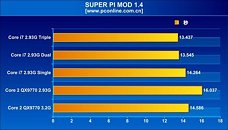

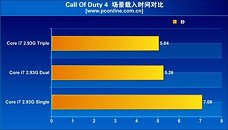
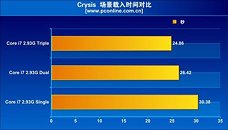
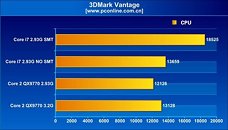
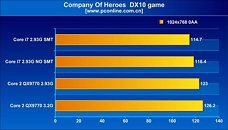
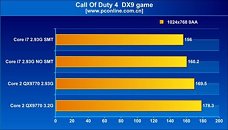
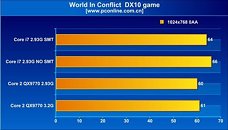


91 Comments on Core i7 940 Review Shows SMT and Tri-Channel Memory Let-down
HT is something that *will* apply to video encoding, as will the ram bandwidth. cant you see those graphs in the first post!
Yeah its not video encoding, but in most reviews i see the performance gains for video encoding, tend to be very similar to winrar/winzip encoding tasks.
I know when I moved from my e6750 @ 3.2 to my x3210 @ 3.2 my encoding speeds increased by about 50%..
Imagine the string I spoke of earlier having extra points of information (up to 16 so far) induced in to it. As long as you read the signal on the other end the same way it was produced, you'll end up with more information on the same stream of electrons in the same amount of time. So on a single sine, you can induce and extract any number of points of data from it.
How exactly they do this, I have no idea. I don't even know how deep the ODR and HDR go (controller to translator on stick or direct to memory modules). I do know it works as seen in the PS3.
Core i7 i think will be a really good thing among the video encoders and photoshop people(and folding), for gaming they arent that great, even if the apps arent multi threaded, that still isn't much of an excuse as to why it cant beat the QX9770, with the apps of today.
Maybe when games use more cores, core i7 will be useful but even then i dont see a huge leap over the Core 2's.
Hearing this is even more disappointing news for the gamers.
Professional workstations... They are not overclocked and they need to be powerful and stable.
It just uses 8 bit wide lanes to achieve 8 bits per clock per lane, but I fail to see how that is octal pumped.
From the Cell (microprocessor)wiki article:It's a completely different technology, with it's pros and it's cons. It's been long since DDR SDRAM probed to be the better economical RAM solution while providing almost the same performance as Rambus memory. XDR is better for embedded solutions that don't require too much memory.
I also still fail to see how you could do quad pumped SDRAM, that is that each memory cell performs 4 ops per clock cycle. And I also don't understand what would be the benefit of that, versus a DDR RAM with double the speed. I.e if your memory cells can perform 1600MT/s wouldn't it be better (simpler, easy to implement, cheaper...) a DDR running at 800Mhz than a "QDR" at 400Mhz?
What i really want to see, is multiple programs running at once. Tri-Chinal might not be good for games or most other applications, but perhaps it will do well in a multitasking world, where people are running at least 4 programs at once.
We need multitasking benchmarks.
They did not use Tri-Channel certified kit to do the test. The system was running at Dual channel mode although three are used.
Tri-channel REQUIRE Tri-Channel Certified Memory Kit like the A-DATA news we have seen previously.
www.techpowerup.com/72926/A-Data_Releases_Tri-Channel_Memory_Kits_for_Intel_X58_Platform.html
You cannot just buy 2 x Dual Channel Kit and grab 3 out of 4 sticks because that will not enable true Tri-Channel mode.
You can either buy 3 packs of of 2x1GB or, you can buy 2 packs of 3x1GB sticks. Its all the same.
First of all there is no way for the computer to tell if its certified or not, and I doubt its an entire different line of ram..
It's like dual channel certified kits, you don't need that either, but they said you did.
Or you can say that both MB & RAM Manufacturers need to Cross-Certify because MB BIOS is involved in that as well.
But of course, you are most welcome to check with ASUS, Gigabyte, MSI, or any manufacturer that is going to sell the X58 boards. :)
It's multi level marketing and cross marketing, if Asus says Crucial ram, Micron pays them.
since you are from Taipei, Taiwan, maybe you have some of these samples ? you may be right , but that is a big maybe
I also think its marketing BS
Its common sense. This way, an average Joe or Jane feels better about their purchase because it has word "certified" on the package.
So let it go.
Notes:
1. Three (3) sticks out of Dual Channel Memory kits, test didn't show any gain.
2. Certified version of Tri-Channel memory shows large performance gain.
3. Circuitry differences.
if i buy 3x 1gb single or 3 paks of 2x2/2x1 or a 3 pack it all runs trichannel can also run dual channel
i wil profe to you that 3x dual channel pack can run tri channel once i got my stuff